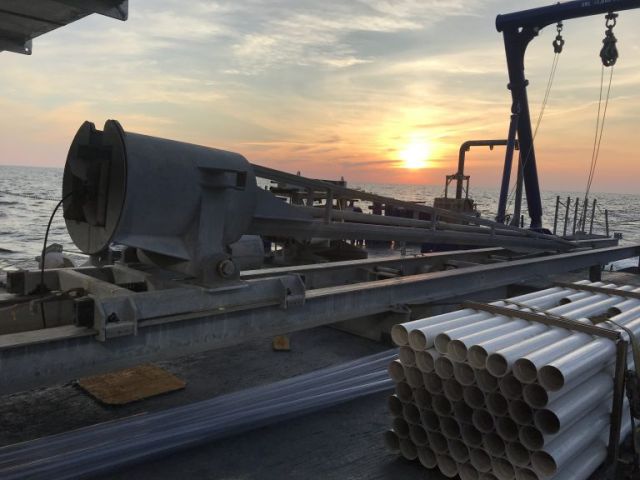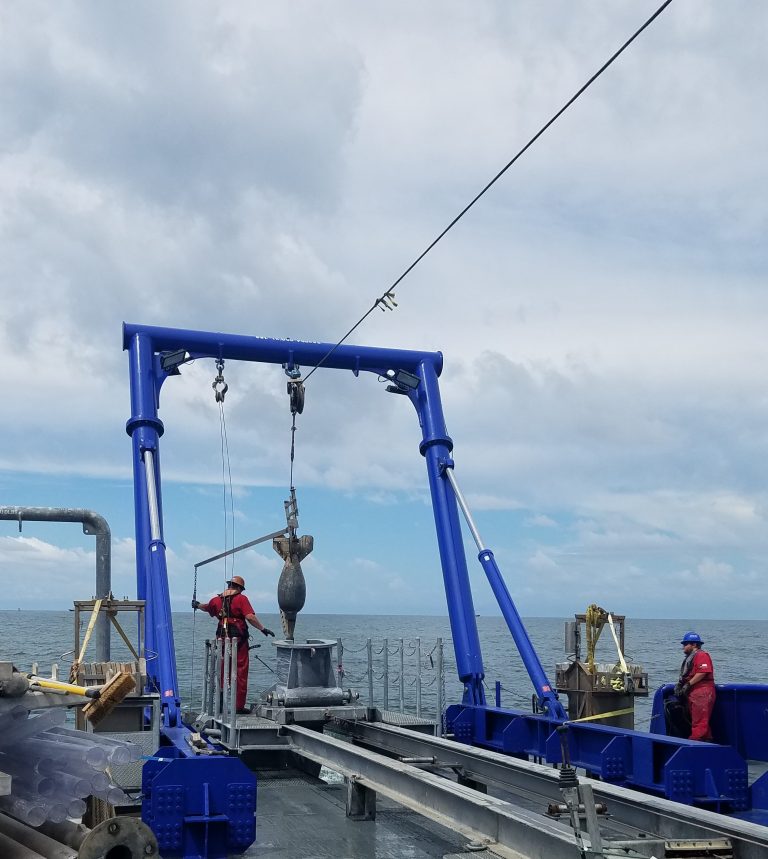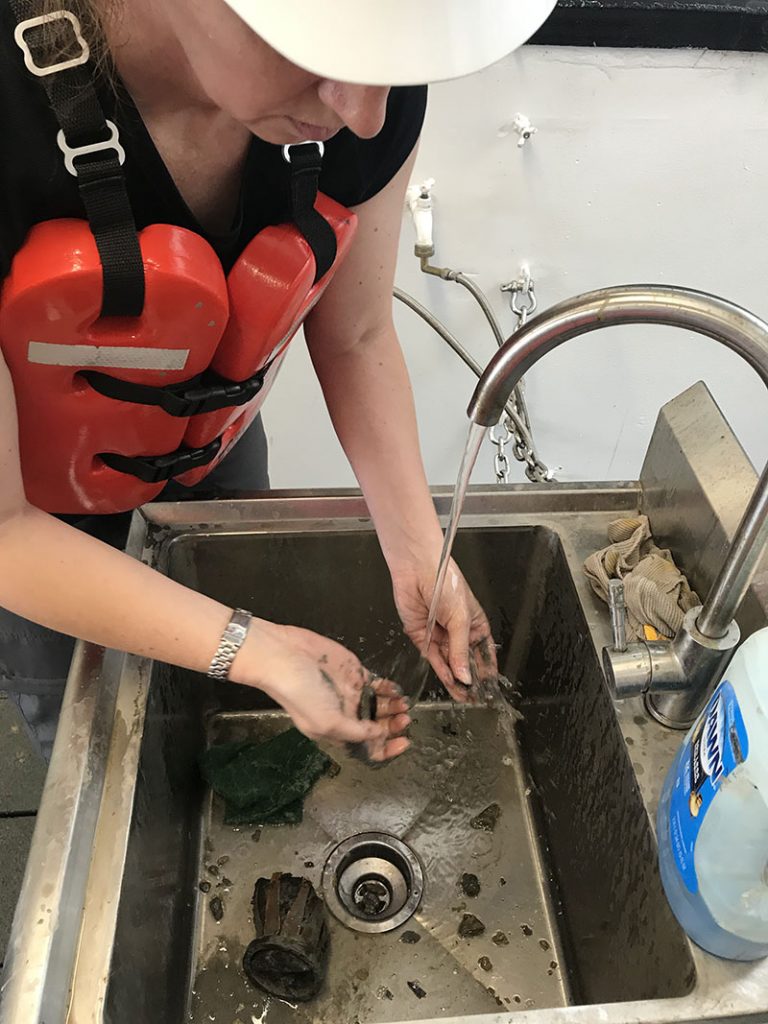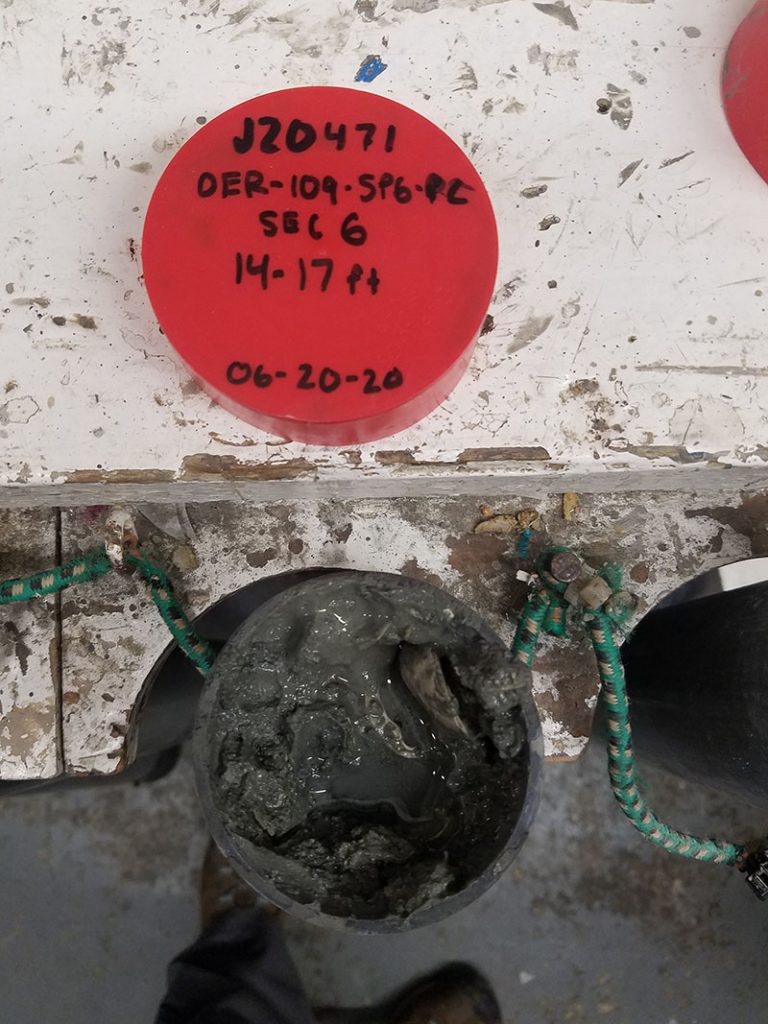
With the sun rising over the horizon, the coring rig sits ready for deployment. (Source: A. Herrera-Schneider, TDI-Brooks)
TDI-Brooks was contracted by Coastal Environments Inc. and Gray & Pipe Inc., who received funding from NOAA’s Office of Ocean Exploration and Research, for this expedition on July 1.
TDI-Brooks performed geotechnical piston coring at Sabine Pass 6 and High Island Blocks 117, 118, 130, 160, 177, 178 and A7. These efforts are part of the expedition Paleolandscapes and the ca. 8,000 BP Shoreline of the Gulf of Mexico Outer Continental Shelf 2020, to add more information about the environment in which early Gulf Coast inhabitants would have lived.
The original geophysical data collected in the early 1980s were printed on thermal paper, before digital data were available, and had become unusable. Coring locations were selected based on 2019 data, as well as by attempting to relocate some of the original cores.
The NOAA Office of Ocean Exploration and Research (OER) supports research expeditions to explore previously unvisited areas of the ocean. OER provides partnership coordination, funding, staff, tools, and expertise needed to develop mission plans that deliver rigorous, systematic observations and documentation of biological, chemical, physical, geological, and archaeological aspects of the ocean.
The TDI-Brooks 3-inch-diameter piston coring (PC) system consists of various hardware assemblies designed to be safely and robustly fastened together into a working core rig and deployed to the seabed for extracting a piston core.

TDI-Brooks’ piston core deployed from the stern of the vessel, aimed over the target, and allowed to free fall into the sediment (Figure 2). The main winch, main-line coring rope, and the PC coring A-Frame are used for deploying and retrieving the 3-in. piston core rig on TDI-Brooks vessels. In addition to the deployed hardware, several assemblies are mounted to the vessel working deck to manage the deployment and retrieval of the coring rig.
A piston corer uses a free fall of the coring rig to achieve the desired initial force on impact, and a sliding piston inside the core barrel to reduce inside wall friction with the sediment and to assist in the rapid evacuation of displaced water from the top of the corer.

Once the sample is collected, the entire rig is pulled to the surface and placed back into its cradle, which is then recovered on deck. The cutter head and core catcher are removed from the barrel and the liner removed for inventorying and sectioning. TDI said it rinsed and bagged anything from the core catcher and drill bit, but the only other opportunity to see what the company might have, came when TDI sectioned the 6-meter (20-foot) long core barrel into smaller sections for transportation and storage (Figures 3 and 4).

A digital photograph is taken and a visual description of each section is recorded. Lab testing as outlined in the field sediment testing protocol is performed and the top of the core section is capped. Top and bottom caps are securely taped to the liner. The core sections are stored and secured in a vertical position with the deeper portion of the section on the bottom. The core sections are stored in a manner to minimize individual movement with vessel heave, pitch, and roll. After completion of the coring activities, the core sections are delivered to TDI-Brooks’ onshore geotechnical testing laboratory in a timely, uninterrupted manner.
Recommended Reading
Rhino Taps Halliburton for Namibia Well Work
2024-04-24 - Halliburton’s deepwater integrated multi-well construction contract for a block in the Orange Basin starts later this year.
Halliburton’s Low-key M&A Strategy Remains Unchanged
2024-04-23 - Halliburton CEO Jeff Miller says expected organic growth generates more shareholder value than following consolidation trends, such as chief rival SLB’s plans to buy ChampionX.
Deepwater Roundup 2024: Americas
2024-04-23 - The final part of Hart Energy E&P’s Deepwater Roundup focuses on projects coming online in the Americas from 2023 until the end of the decade.
Ohio Utica’s Ascent Resources Credit Rep Rises on Production, Cash Flow
2024-04-23 - Ascent Resources received a positive outlook from Fitch Ratings as the company has grown into Ohio’s No. 1 gas and No. 2 Utica oil producer, according to state data.
E&P Highlights: April 22, 2024
2024-04-22 - Here’s a roundup of the latest E&P headlines, including a standardization MoU and new contract awards.





